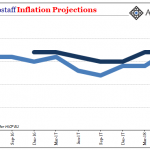As part of its effort to stress its own self-importance, the Federal Reserve conducts a survey of the Primary Dealer members through its New York branch. A written questionnaire is sent out to each bank in advance of every monetary policy meeting. The purpose is for monetary policymakers to make sure that there aren’t any big surprises, that the market, or, in this case, orthodox Economists working for one part of the market, is seeing things consistent with how the Fed wants them to.
In September 2013, the Primary Dealer Survey questions included a few pertaining to the then ongoing “taper tantrum” roiling markets around the world. It was “reflation” #2 and like the others, both the one before and the one after, it came on rather quickly and harshly. On the issue of benchmark interest rates, in the form of the UST 10s, the Primary Dealers all saw interest rates rising still further into the foreseeable future.
Of those surveyed, 65% believed that the 10-year yield would be above 3% by the end of 2014; more than three-quarters, 78%, thought the same for the end of 2015, including 15% who were expecting the 10s to get above 4.50% compared to just 6% who guessed, correctly, 2.01% to 2.50%.

With the long end of the treasury curve trading sideways to slightly lower over the past nearly two months, that means yields here are lower today than one year ago. But, as you can plainly see above, the Primary Dealers never, ever expect rates to go lower. They are seriously biased toward rising nominal yields not just at the right of the curve but in all spaces.
One of the problems with at least the Dealer survey is, again, it’s not really the Dealers who are being surveyed; it is the Economists at those banks who are given the task of reporting to other Economists at the Fed for what the “market” thinks is going on. This is not the first time such massive disconnect or even dissonance has played out in this fashion.
Practically the whole of the last ten plus years has been in one way or another Economists confirming each other with each other and then wondering why it never works out that way. In early 2007, at a time when there was at least a chance something might have been done before the worst of the panic, the FOMC spent a lot of time dismissing the market verdict of eurodollar futures which was very plain in suggesting grave, broad market concerns about what was unfolding – that subprime wasn’t the real element to focus on.
Eurodollar futures were in policy discussions dismissed outright for among other reasons the surveys. These had showed Economists at the Primary Dealers expecting other things than the traders at those very same firms who were actually putting those firms’ money into those alarming of eurodollar futures.














Leave A Comment